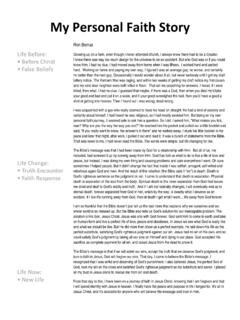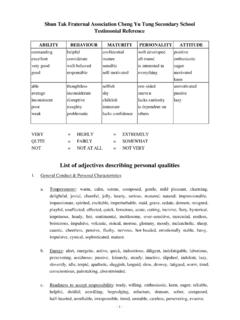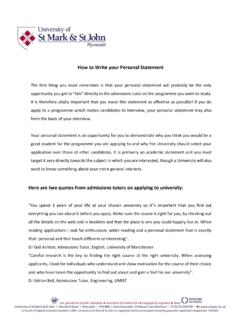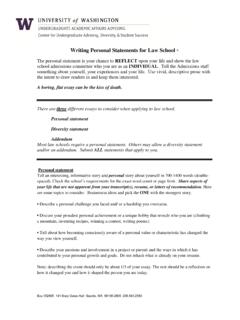Transcription of Personal, domestic and community hygiene
1 65 CHAPTER 8 personal , domestic and community hygieneGood hygiene is an important barrier to many infectious diseases, includingthe faecal oral diseases, and it promotes better health and achieve the greatest health benefits, improvements in hygiene should bemade concurrently with improvements in the water supply and sanitation,and be integrated with other interventions, such as improving nutrition andincreasing incomes. The next sections discuss how to improve personal andcommunity hygiene practices that help to prevent the spread of faecal wastewater is not disposed of effectively it can serve as a breedingground for mosquitoes.
2 People may also slip and fall in muddy puddles, andchildren may play in them and risk waterborne illness. and domestic handwashing is one of the most effective ways of preventing thespread of diarrhoeal diseases. Pathogens cannot be seen on hands, and wateralone is not always sufficient to remove them. Soap and wood ash are bothcleansing and disinfecting agents when used with water and can be used tokill pathogens on hands and utensils. The most important times that handsshould be washed with soap and water are: After defecating. After cleaning a child who has defecated. Before eating or handling good personal hygiene often requires that community membersare mobilized towards this goal and awareness is raised about how to achieveit.
3 It is important that hygiene education programmes do more than simplytell people that if they do not wash their hands they will become sick because of pathogens they cannot see. This rarely works. Instead, education pro-grammes should try different methods to maximize community participation66 HEALTHY VILLAGES: A GUIDE FOR COMMUNITIES AND community HEALTH WORKERSin the programmes and to encourage people to promote good hygiene . Somemethods for promoting hygiene and health are discussed in the next encourage handwashing to become part of the daily routine, suitablefacilities must be located near to places such as latrines and kitchens, wherethey will be needed.
4 If running water is available, the facilities should includea tap and a sink as well as soap. Hands may also be washed at a tap standas shown in Figures and If running water is not available, an oil canor bucket fitted with a tap is a simple way of providing handwashing facili-ties; the larger the container, the less frequently it will need filling. Some con-tainers are mounted on stands with a ledge for soap. A leaking container (suchas a tin can with holes in its base) can also be used to scoop water from thewater storage container and provide a stream of running water for hand-washing.
5 Another approach involves a suspended container that, whentipped, pours water onto the hands of the user. The system can easily be made from plastic cooking oil containers. Soap itself can be kept clean by sus-pending it above the ground on a bathing and laundering are important for cleanliness and good per-sonal appearance. They also prevent hygiene -related diseases such as scabies,ringworm, trachoma, conjunctivitis and louse-borne typhus. Educational andpromotional activities can encourage bathing and laundering, but increasingthe number of washing facilities and locating them conveniently may be moreeffective.
6 Bathing with soap is an important means of preventing the trans-mission of trachoma an illness that can cause blindness and other eyesightproblems. Children s faces in particular should be washed regularly and thor-oughly. If a child has trachoma, a special towel or tissue should be used towipe or dry the child s face; the towel should never be used for other chil-dren because of the risk of transmitting the disease. Ideally, programmes thatpromote bathing should be combined with a programme to reduce thenumbers of flies, which spread trachoma and other diseases, and to improve people to bathe thoroughly they must use sufficient water, but it maybe difficult to promote the use of more water for washing if water suppliesare distant and water must be collected by hand.
7 Moreover, many traditionalbathing practices do not use water efficiently and ensuring cleanliness maybe difficult. By modifying existing practices, such as by encouraging the useof water containers with taps, it may be possible to improve the efficiency ofwater use. community shower units, with separate facilities for men andwomen, can also become income-generating enterprises in larger villages, butthe facilities require careful maintenance and must be conveniently should also allay concerns about voyeurism, which may be CHAPTER 8. personal , domestic AND community HYGIENE67 Figure using a tapFigure at a standpost68 HEALTHY VILLAGES: A GUIDE FOR COMMUNITIES AND community HEALTH WORKERS particularly important to women.
8 Such problems are best resolved throughdiscussion within the promote laundering of clothes and bedding, laundry slabs or sinks can beconstructed near water points. They should be large enough to wash beddingand other bulky items and be situated so that water drains away from thelaundry area and away from the water source. Locating laundry places innatural water bodies, streams and irrigation canals is best avoided if possi-ble, since this practice can contribute to the transmission of hygieneSome health measures can be undertaken only by the community as a whole; these include water source protection, proper disposal of solid waste and excreta, wastewater drainage, controlling animal rearing and markethygiene.
9 Some of these issues have been described in earlier community members play an important role in communityhygiene, and have a responsibility to their neighbours and to the community to promote good health and a clean environment. For example, everyone inthe village must keep their houses and compounds clean, because one dirtyhouse can affect many conscientious neighbours and contribute to the spreadof disease. community leaders can promote cleanliness in the home by reg-ularly checking on village households and by using by-laws to encouragehousehold often represent a health hazard because foodstuffs may not be storedproperly and because the markets may lack basic services, such as watersupply, sanitation, solid waste disposal and drainage.
10 Ideally, markets shouldhave several taps to provide traders and customers with ready access to safewater for drinking and washing. Many vegetable and fruit sellers regularlysprinkle their produce with water, and it is important that they have accessto clean water for this. The sanitation facilities should also be appropriate forthe number of people who will visit the market, with separate facilities formen and women. Water and sanitation facilities for a market are often rela-tively easy to support by charging a small user fee, or by using part of themarket fee to pay for such services.
















